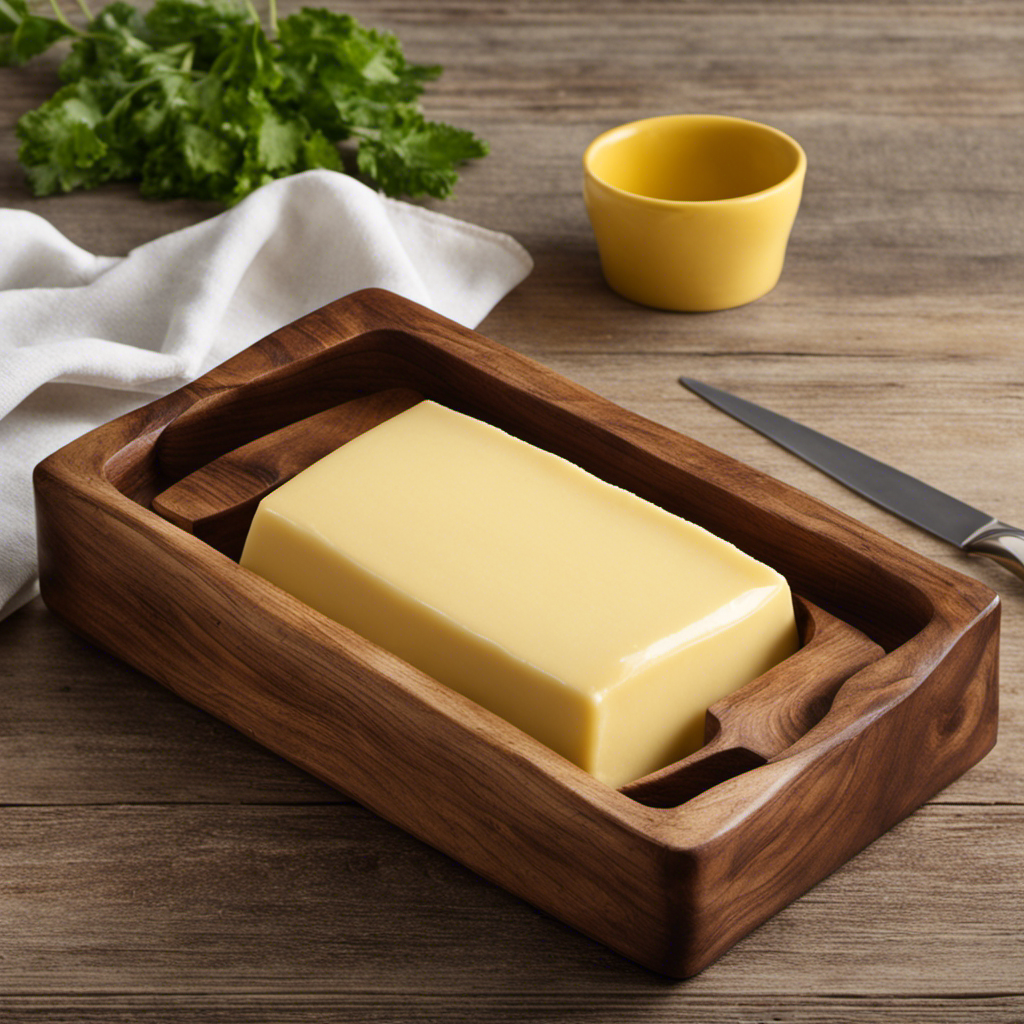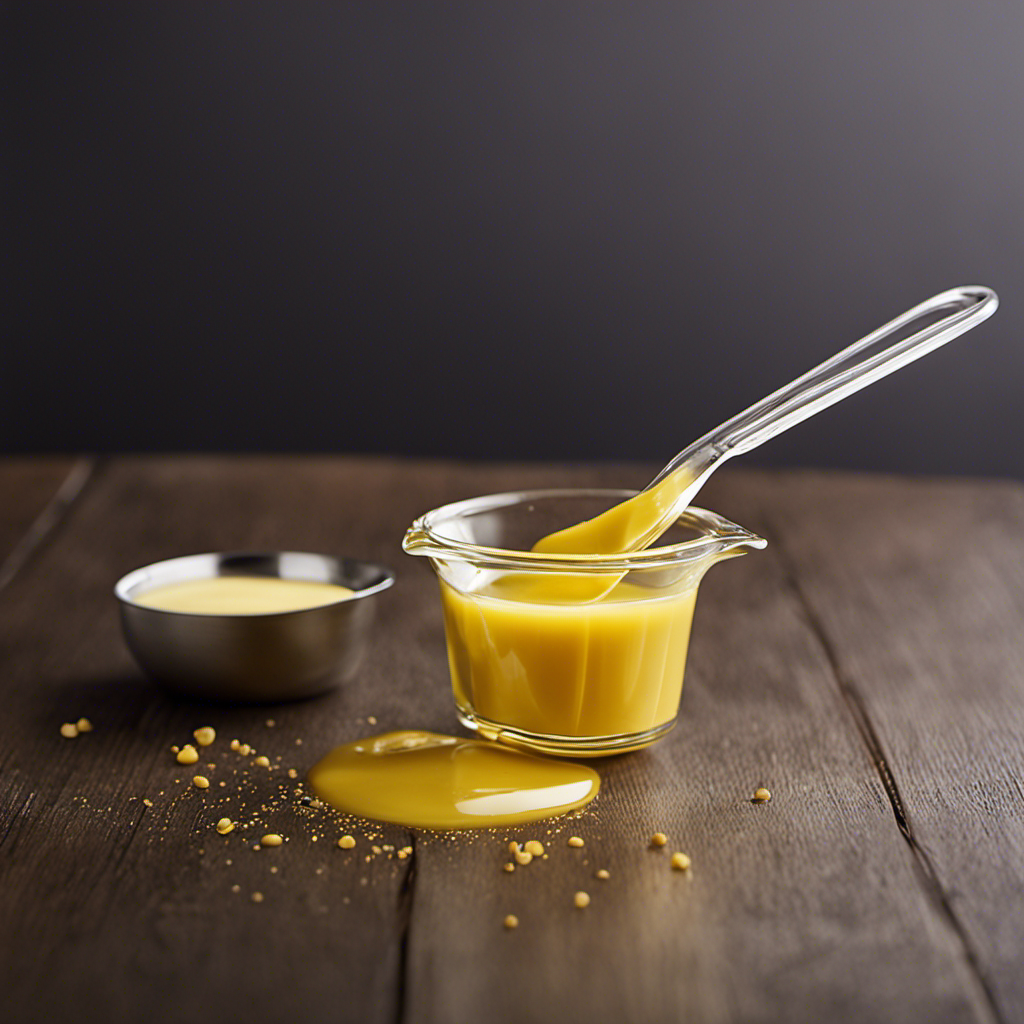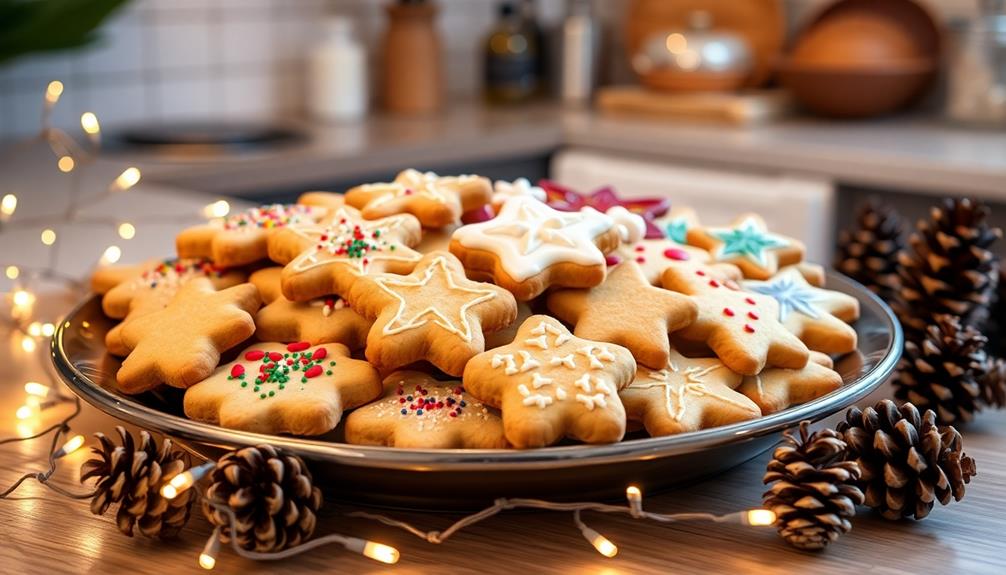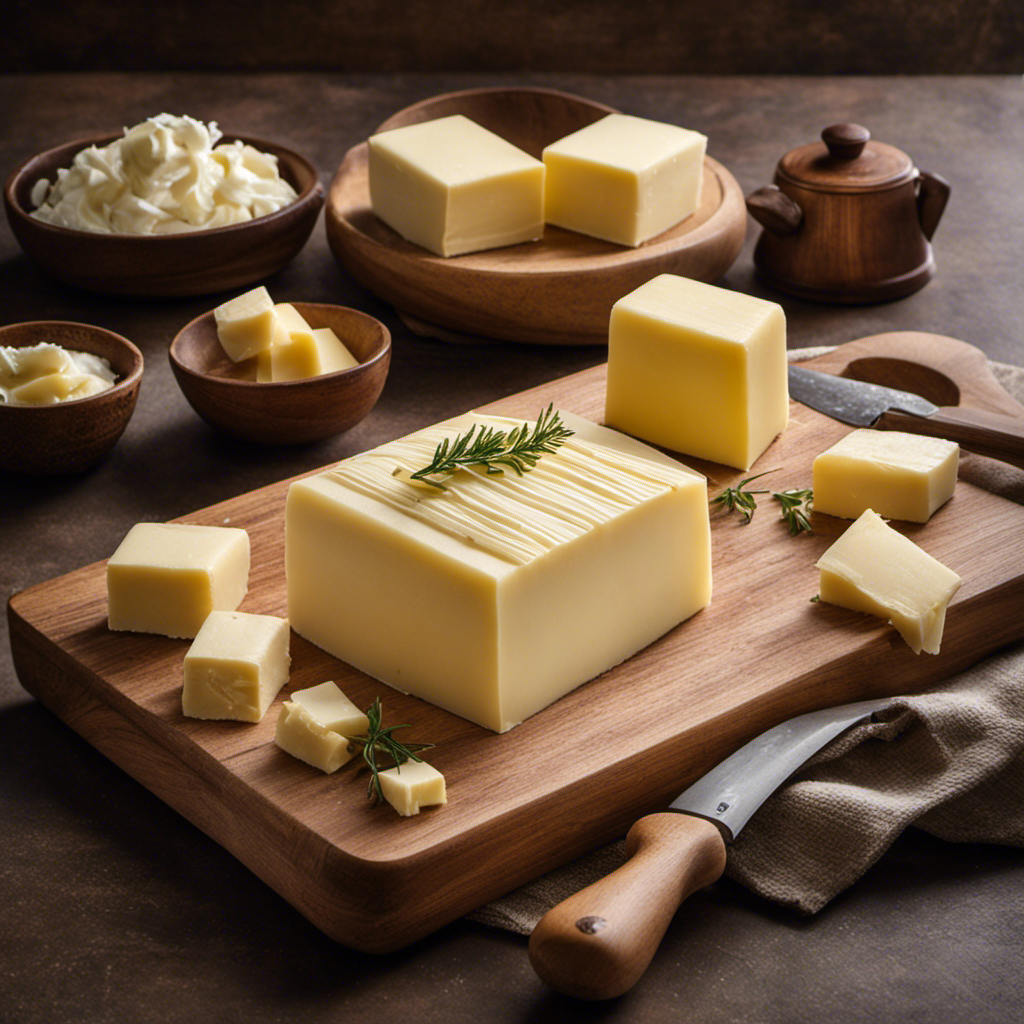As someone who has a keen interest in butter, I frequently find myself in the kitchen pondering the precise number of ounces contained in a single stick of butter. While it might appear to be a straightforward question, getting the answer right is essential for adhering to recipe measurements with precision.
In this article, we’ll dive into the world of butter measurements, decoding packaging, and calculating the weight of a typical butter stick. So, if you’re ready to unlock the mysteries of butter portions in ounces, let’s get started!
Key Takeaways
- A standard stick of butter in the United States is typically 4 ounces or 113 grams.
- Some European countries have different butter stick sizes, such as 8 ounces or 250 grams.
- Butter packaging can include sticks, blocks, or tubs, and sizes may vary between brands and regions.
- Measuring cups can be used to measure butter accurately, but converting butter to grams provides a more precise measurement.
Butter Measurements Explained
Do you know how many ounces one stick of butter is?
Butter stick sizes can vary, depending on where you live. In the United States, a standard stick of butter is typically 4 ounces or 113 grams. This stick is usually marked with tablespoon measurements on the packaging, making it easier to measure when cooking or baking.
However, in some European countries, butter sticks can come in different sizes, like 8 ounces or 250 grams. It’s important to check the packaging or consult a conversion chart if you are using a recipe from a different country.
Understanding butter packaging is crucial for accurate measurements in your recipes. Now, let’s delve into the different types of butter packaging and their measurements.
Understanding Butter Packaging
When it comes to butter packaging, there can be confusion about the different measurements and units used. It is important to understand the various packaging options available, such as sticks, blocks, or tubs, in order to accurately measure the amount of butter needed for a recipe.
Butter Packaging Confusion
The butter packaging can be confusing because it doesn’t clearly indicate how many ounces are in one stick. As a consumer, it’s frustrating to not have this information readily available. To further complicate matters, butter package sizes can vary depending on the brand and region. To help clarify this confusion, I’ve compiled a table with common butter package sizes and their respective stick dimensions:
| Package Size | Stick Dimensions |
|---|---|
| 1 lb | 4" x 1" x 1" |
| 8 oz | 4" x 1" x 1/2" |
| 4 oz | 2" x 1" x 1/2" |
| 2 oz | 2" x 1" x 1/4" |
| 1 oz | 2" x 1" x 1/8" |
This table provides a useful reference for understanding the dimensions of butter sticks in different package sizes. It’s important to note that these dimensions may vary slightly between brands, so always check the packaging for accurate information.
Measuring Butter Accurately
Measuring butter accurately can be challenging without clear indications on the packaging about the dimensions of each stick. When a recipe calls for a specific amount of butter, it’s important to get it right.
In addition to using measuring cups, there are other alternatives to measure butter accurately. One way is to convert butter to grams, which provides a more precise measurement. To do this, simply multiply the number of sticks of butter by 113.4 grams.
For example, if a recipe calls for 2 sticks of butter, you would multiply 2 by 113.4 to get 226.8 grams. This conversion method ensures that you are using the exact amount of butter required for your recipe, resulting in consistent and delicious results.
Decoding Butter Stick Sizes
Decoding butter stick sizes can be confusing, so let’s figure out how many ounces are in one stick of butter. It’s important to know the measurements when following a recipe accurately.
Here’s a breakdown of butter stick sizes and their corresponding ounces:
- 1 stick of butter = 4 ounces
- 2 sticks of butter = 8 ounces
- 4 sticks of butter = 16 ounces (1 pound)
- 8 sticks of butter = 32 ounces (2 pounds)
Understanding these conversions can make a big difference in your cooking and baking endeavors. Whether you need to halve a recipe or double it, knowing the ounces in a stick of butter will help you achieve the perfect results every time.
How Much Butter Is in One Stick
To figure out how much butter is in one stick, just remember that it equals 4 ounces. This standard measurement is used in many recipes as a convenient way to portion out butter. However, it’s important to know that butter stick sizes can vary depending on where you live. In the United States, a stick of butter is typically 1/2 cup or 8 tablespoons, which equals 4 ounces. But in other countries, like Australia or the United Kingdom, butter sticks can be different sizes. For example, in Australia, a stick of butter is 250 grams, which is approximately 8.8 ounces. It’s always a good idea to check the packaging or use a kitchen scale to ensure accurate measurements when converting butter sizes for your recipes.
| Country | Butter Stick Size | Equivalent Ounces |
|---|---|---|
| United States | 1 stick | 4 ounces |
| Australia | 1 stick | 8.8 ounces |
| United Kingdom | 1 stick | 4.4 ounces |
| Canada | 1 stick | 4 ounces |
| Germany | 1 stick | 4.4 ounces |
The Weight of a Typical Butter Stick
It’s important to be aware that the weight of a typical butter stick can vary depending on the country you’re in. In the United States, a standard butter stick weighs 4 ounces or 113 grams. However, in other countries like Australia and New Zealand, a butter stick weighs 250 grams or 8.8 ounces.
To accurately measure butter, it’s best to use a kitchen scale for precise results. Here are some tips for measuring butter accurately:
- Place a container on the scale and set it to zero.
- Cut the desired amount of butter from the stick and place it in the container.
- Check the weight on the scale to ensure you have the correct amount.
- Adjust as needed to get the accurate measurement.
Unraveling Ounce Measurements for Butter
Decoding butter packaging can be a bit confusing, especially when it comes to understanding the ounce measurements. To make things easier, I’ve put together a handy table that shows the butter stick equivalents in ounces:
| Butter Stick | Ounces |
|---|---|
| 1 | 4 |
| 2 | 8 |
| 4 | 16 |
| 8 | 32 |
| 16 | 64 |
As you can see, one stick of butter typically weighs 4 ounces. But if a recipe calls for 8 ounces of butter, you would need to use two sticks. Similarly, if you need 16 ounces, you would use four sticks. This table can serve as a useful reference when trying to decipher butter measurements in recipes. So, the next time you’re in the kitchen and need to measure out butter, you’ll be able to do so with confidence.
Butter in Ounces: A Handy Guide
When it comes to baking or cooking, butter measurement conversions can be a bit confusing. In this discussion, we will explore the ounces to butter ratio and provide a handy guide for butter stick equivalents.
Understanding these measurements will ensure accurate and delicious results in your recipes. So let’s dive in and unravel the mysteries of butter measurements!
Butter Measurement Conversions
To convert a stick of butter to ounces, you need to know that one stick is equal to 4 ounces. This is a common measurement used in recipes and baking. It’s important to be familiar with butter measurement equivalents to ensure accurate results in your cooking.
Here are some key conversions to keep in mind:
- 1 stick of butter = 4 ounces
- 1/2 stick of butter = 2 ounces
- 1/4 stick of butter = 1 ounce
- 1 tablespoon of butter = 0.5 ounces
These conversions can come in handy when you come across a recipe that lists butter measurements in different units. By knowing these equivalents, you can easily convert between sticks and ounces and vice versa. This knowledge will make your cooking experience more efficient and help you achieve the desired results in your dishes.
Ounces to Butter Ratio
Converting ounces to butter can be easily done using the measurement equivalents mentioned earlier.
When it comes to butter weight conversions, it’s important to know that one stick of butter is equal to 4 ounces. This means that if you have 8 ounces of butter, you would have 2 sticks. Similarly, if you have 16 ounces of butter, you would have 4 sticks.
Converting butter to weight is a straightforward process, as long as you remember the ratio of 1 stick to 4 ounces. This knowledge comes in handy when following recipes that require specific measurements of butter.
Butter Stick Equivalents
Knowing the equivalent of one stick of butter is useful when following recipes that call for specific measurements. However, the confusion arises due to the different sizes of butter sticks and the way they are packaged. Here are some key points to keep in mind:
- Butter stick sizes can vary, but the most common size is 1/2 cup or 8 tablespoons.
- Some butter brands package their sticks in 1/4 cup or 4 tablespoon sizes, so two of these would be equivalent to one stick.
- It is important to check the packaging and read the label to determine the exact size of the butter stick.
- If a recipe calls for a certain number of sticks of butter, it is crucial to know the size of the stick to accurately measure the amount needed.
Understanding the different butter stick sizes and packaging can help avoid confusion and ensure accurate measurements in recipes.
Now, let’s move on to calculating butter portions in ounces.
Calculating Butter Portions in Ounces
Did you know that one stick of butter is equivalent to 4 ounces? When it comes to butter weight conversions and butter portioning techniques, it’s important to have accurate measurements for successful baking and cooking. To help you with that, here is a table that shows the conversion of butter sticks to ounces:
| Butter Sticks | Ounces |
|---|---|
| 1 | 4 |
| 2 | 8 |
| 3 | 12 |
| 4 | 16 |
| 5 | 20 |
This table can be a handy reference when you need to measure butter for your recipes. Whether you need to divide a stick of butter into smaller portions or convert a recipe that uses ounces, these measurements will ensure accuracy in your cooking. So, the next time you’re in the kitchen, remember that one stick of butter equals 4 ounces.
Converting Butter Sticks to Ounces
When you’re in the kitchen, it’s helpful to remember that a stick of butter is equivalent to 4 ounces. This measurement is standardized and widely used in recipes.
However, if you come across a recipe that provides the butter stick weight in grams, you may need to convert it to ounces. To convert grams to ounces, you can use the following formula: divide the number of grams by 28.35.
Here are four key points to keep in mind when converting butter stick weight from grams to ounces:
- A stick of butter weighs 113 grams.
- To convert grams to ounces, divide the number of grams by 28.35.
- For example, if a recipe calls for 226 grams of butter, divide 226 by 28.35 to get 7.98 ounces.
- Round the result to the nearest hundredth, so in this case, it would be 8 ounces.
Popular Butter Brands and Ounce Equivalents
If you’re a fan of baking, you’ve probably noticed that Land O Lakes and Challenge are two popular brands of butter.
When it comes to converting butter measurements, it’s important to know the ounce equivalents for these brands.
Typically, one stick of butter weighs 4 ounces or 113 grams.
For Land O Lakes butter, each stick is labeled as 1/2 cup or 8 tablespoons, which equals to 4 ounces.
Challenge butter, on the other hand, is labeled as 1/4 pound or 1/2 cup, also equivalent to 4 ounces.
These conversion factors can be handy when following recipes or when you need to measure butter accurately.
Tips for Measuring Butter Accurately
When it comes to baking, accurate measuring is crucial, especially when it comes to butter. Understanding butter measurement conversions is essential to ensure the right amount is used in recipes.
In this discussion, I will explore the importance of accurate measuring and provide tips for achieving precise measurements when working with butter.
Butter Measurement Conversions
To measure one stick of butter, you’ll need to know that it equals 8 ounces. Converting butter weights can be tricky, but with these tips, you’ll be able to do it accurately:
- Use a kitchen scale: Weighing butter ensures precise measurements.
- Convert from cups: If a recipe calls for cups instead of sticks, use a conversion chart to determine the equivalent amount.
- Consider butter packaging: Different brands may have different sizes for a stick of butter, so always check the label.
- Adjust for temperature: Butter can expand or contract depending on its temperature, so measure it when it’s at room temperature for accurate results.
Importance of Accurate Measuring
Accurate measuring is essential for achieving consistent and successful baking results. When it comes to butter, using the correct measuring techniques is crucial.
Butter is often measured in sticks, and knowing the weight of one stick can make a big difference in your recipe. One stick of butter typically weighs 4 ounces, or 113 grams. However, it’s important to note that butter sticks can vary in weight depending on the brand and country you are in.
Consistency in measuring the butter ensures that you are using the right amount in your recipe, which can affect the texture and taste of your baked goods. So, whether you’re using a scale or measuring by the stick, being precise and consistent with your butter measurement is key to achieving delicious results every time.
Tips for Precise Measurements
Using the correct measuring techniques is essential for achieving precise and consistent baking results. As a home baker, I’ve learned a few tips for ensuring accurate measurements that I’d like to share.
Here are some common mistakes in measuring and how to avoid them:
-
Use the correct measuring tools: Invest in a set of measuring cups and spoons that are designed for baking. Using random utensils can lead to inaccurate measurements.
-
Level off dry ingredients: When measuring ingredients like flour or sugar, use a straight edge (like a knife) to level off the top of the measuring cup. This ensures that you’re not adding too much or too little.
-
Spoon and level with sticky ingredients: For ingredients like honey or peanut butter, use a spoon to transfer them into the measuring cup, then level off the top with a knife.
-
Read the measurements at eye level: When measuring liquids, make sure you’re reading the markings on the cup at eye level to avoid any errors.
Frequently Asked Questions
Can I Use Margarine Instead of Butter in a Recipe?
Yes, margarine can be used as a substitute for butter in recipes. However, it is important to note that margarine and butter have different health benefits and nutritional profiles. Margarine is often considered a healthier option due to its lower saturated fat content.
How Much Butter Should I Use if a Recipe Calls for One Stick of Unsalted Butter?
If a recipe calls for one stick of unsalted butter, you should use 4 ounces. To substitute unsalted butter, use margarine in the same quantity. To convert measurements from sticks to cups, 1 stick equals 1/2 cup.
How Many Tablespoons Are in One Stick of Butter?
In different recipes, using butter adds flavor and richness. It enhances the texture of baked goods, making them moist and tender. The amount of butter in one stick is equivalent to 8 tablespoons.
Are There Any Substitutes for Butter in Baking?
When it comes to baking, there are several substitutes for butter. Each has its advantages and disadvantages. From coconut oil to applesauce, these alternatives can add different flavors and textures to your baked goods.
How Can I Measure Butter Accurately if I Don’t Have Measuring Cups or Spoons?
When measuring butter without tools, estimating quantities can be tricky. However, there are some general guidelines you can follow. For example, a stick of butter is typically 4 ounces or 113 grams.
Conclusion
In conclusion, understanding the measurement of butter sticks is crucial for accurate baking and cooking.
By decoding the packaging and calculating the weight in ounces, you can easily convert butter sticks to the desired amount.
Popular butter brands also provide ounce equivalents for convenience.
Remember to measure butter accurately to ensure the best results in your recipes.










